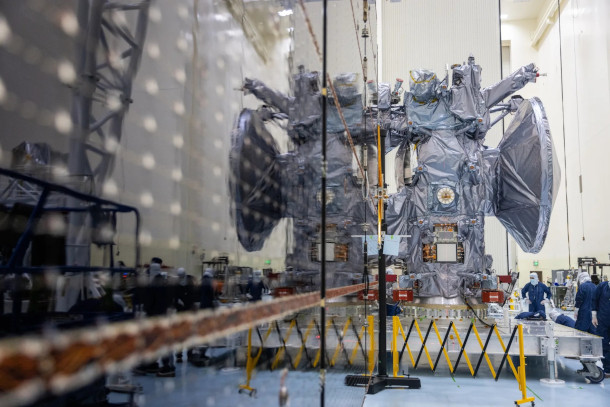Europa Clipper On Its Way
Air Date: Week of October 18, 2024

The Europa Clipper spacecraft undergoes installation of its five-panel solar array in August 2024. (Photo: NASA’s Marshall Space Flight Center, Flickr, CC BY-NC 2.0)
The Europa Clipper spacecraft recently blasted off into space to start a six-year journey towards Jupiter’s icy moon, Europa. On a series of close flybys, Clipper is designed to gather data that could indicate whether Europa might harbor life in the enormous liquid water ocean it appears to have beneath its icy shell.
Transcript
O’NEILL: After the break we’ll journey to the icy world at the bottom of our planet, Antarctica. But first a quick note on a journey to another icy world that just lifted off. On Monday, October 14th the biggest interplanetary spacecraft ever built by humans blasted off into space. The precious payload of the Falcon Heavy rocket was Europa Clipper, which NASA engineers designed to gather data that could indicate whether Jupiter’s moon Europa might harbor life.
Europa is not exactly Earth-like. For one, Jupiter’s powerful magnetic field zaps its moons with huge amounts of radiation that would be dangerous to us humans. Europa is also so far from the Sun that it receives only about four percent of the sunlight that we enjoy on average. And because of that daytime highs on Europa are a balmy negative two hundred ten degrees Fahrenheit, and nighttime lows can get down to negative three hundred seventy Fahrenheit!
But beneath its thick icy shell, Europa likely has a huge liquid water ocean that just might provide the conditions for microbes to eke out a living. NASA plans to put Europa Clipper on a very elliptical orbit around Jupiter, which will allow it to make dozens of close flybys of the icy moon. But we’ll have to be patient, because it’s expected to take until 2030 just for Clipper to reach Europa. To get that far out into the solar system, the spacecraft will need a couple of gravity assist boosts from Earth and Mars. So if all goes well Europa Clipper should be back in our neighborhood around the end of 2026 before it’s on its way for good.
Links
Living on Earth wants to hear from you!
Living on Earth
62 Calef Highway, Suite 212
Lee, NH 03861
Telephone: 617-287-4121
E-mail: comments@loe.org
Newsletter [Click here]
Donate to Living on Earth!
Living on Earth is an independent media program and relies entirely on contributions from listeners and institutions supporting public service. Please donate now to preserve an independent environmental voice.
NewsletterLiving on Earth offers a weekly delivery of the show's rundown to your mailbox. Sign up for our newsletter today!
 Sailors For The Sea: Be the change you want to sea.
Sailors For The Sea: Be the change you want to sea.
 The Grantham Foundation for the Protection of the Environment: Committed to protecting and improving the health of the global environment.
The Grantham Foundation for the Protection of the Environment: Committed to protecting and improving the health of the global environment.
 Contribute to Living on Earth and receive, as our gift to you, an archival print of one of Mark Seth Lender's extraordinary wildlife photographs. Follow the link to see Mark's current collection of photographs.
Contribute to Living on Earth and receive, as our gift to you, an archival print of one of Mark Seth Lender's extraordinary wildlife photographs. Follow the link to see Mark's current collection of photographs.
 Buy a signed copy of Mark Seth Lender's book Smeagull the Seagull & support Living on Earth
Buy a signed copy of Mark Seth Lender's book Smeagull the Seagull & support Living on Earth

